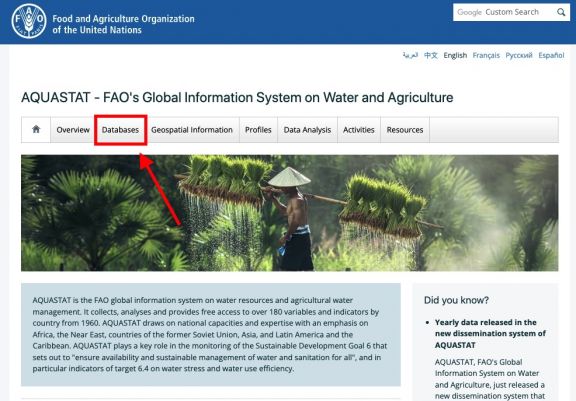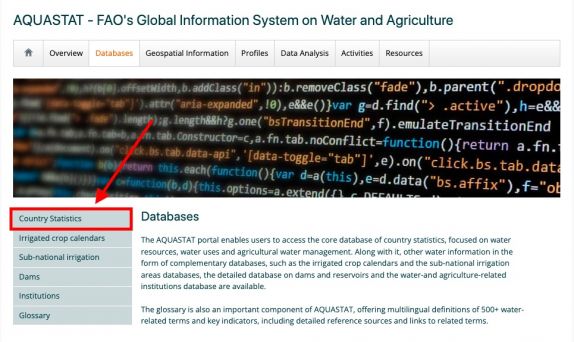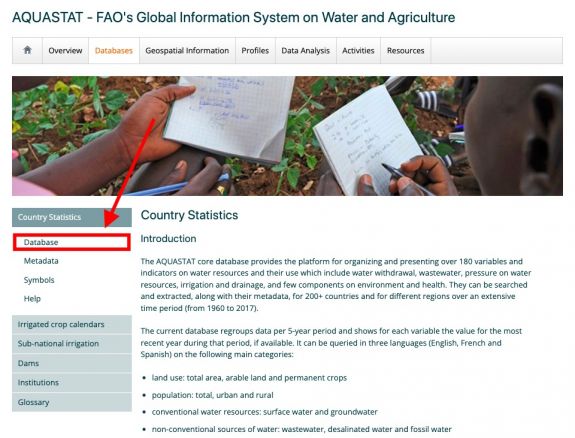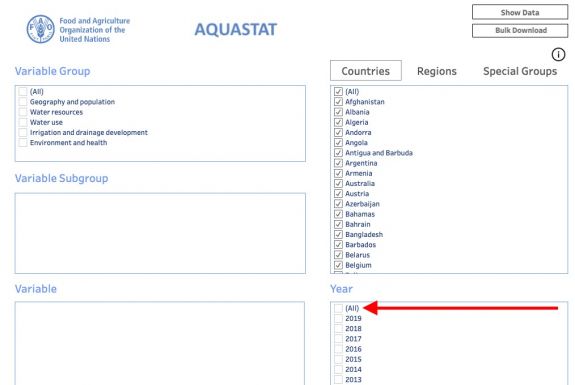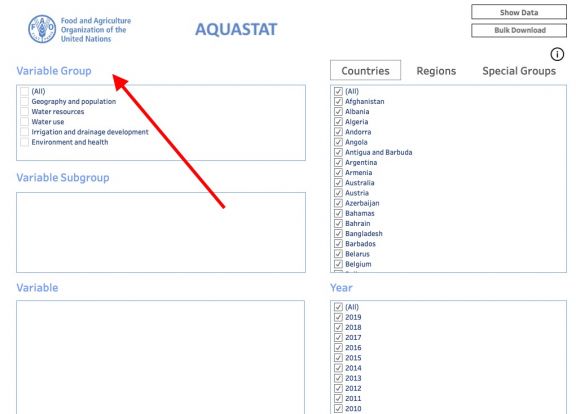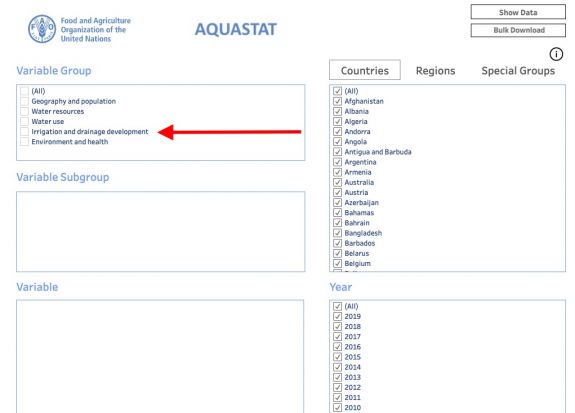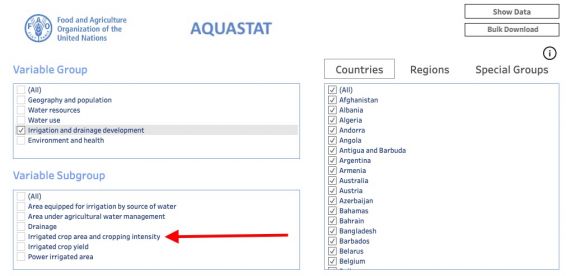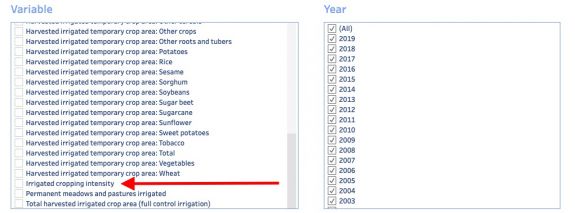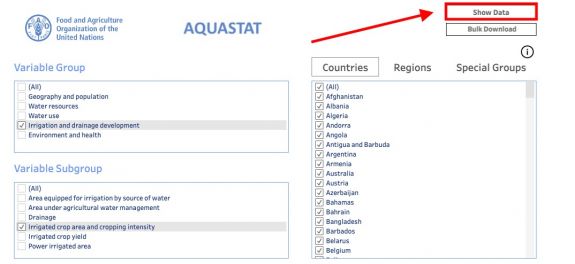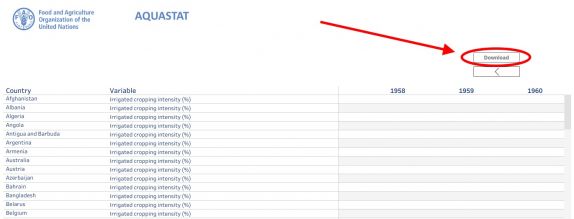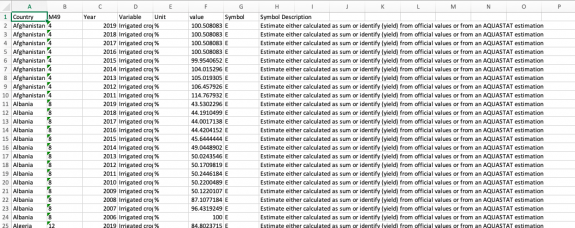Aquastat FAO's Global Information System on Water and Agriculture: Difference between revisions
mNo edit summary |
(added more information to the summary) |
||
| Line 1: | Line 1: | ||
== SUMMARY == | == SUMMARY == | ||
[https://www.fao.org/aquastat/en/ AQUASTAT] is the UN's Food and Agriculture Organization (FAO) global information system on water resources and agricultural water management. It collects, analyzes, and provides free access to over 180 variables and indicators by country and year from 1960. AQUASTAT plays an important role in monitoring of the UN's Sustainable Development Goal 6 that sets out to "ensure availability and sustainable management of water and sanitation for all". Additionally, AQUASTAT's new dissemination system allows users to download up to 100,000 data points. | [https://www.fao.org/aquastat/en/ AQUASTAT] is the UN's Food and Agriculture Organization (FAO) global information system on water resources and agricultural water management. It collects, analyzes, and provides free access to over 180 variables and indicators by country and year from 1960. AQUASTAT plays an important role in monitoring of the UN's Sustainable Development Goal 6 that sets out to "ensure availability and sustainable management of water and sanitation for all". Additionally, AQUASTAT's new dissemination system allows users to download up to 100,000 data points and the data is made available yearly. | ||
The data team uses AQUASTAT for a number of series including SeriesDesalinatedWater, SeriesLandCultivatedArea, and SeriesLandIrWaterLogged to name a few. To pull data into IFs, please follow the instructions found in the [[Data Pull instructions page]]. | |||
== GENERAL STEPS TO PULL DATA FROM AQUASTAT == | == GENERAL STEPS TO PULL DATA FROM AQUASTAT == | ||
| Line 13: | Line 15: | ||
Step 3.) On the left hand side of the page, click on the tab labeled "'''Country Statistics'''" | Step 3.) On the left hand side of the page, click on the tab labeled "'''Country Statistics'''" | ||
[[File:Aquastat IMG STEP 03.jpg|center|thumb|574x574px|AQUASTAT's Database Homepage]] | [[File:Aquastat IMG STEP 03.jpg|center|thumb|574x574px|AQUASTAT's Database Homepage]] | ||
Step 4.) On the left hand side of the page, click on the tab labeled "'''Database'''", under "Country Statistics" | Step 4.) On the left hand side of the page, click on the tab labeled "'''Database'''", under "Country Statistics" | ||
| Line 20: | Line 20: | ||
THIS WILL OPEN A PAGE ON ANOTHER TAB | THIS WILL OPEN A PAGE ON ANOTHER TAB | ||
[[File:Aquastat IMG STEP 04 Actual.jpg|center|thumb|575x575px|AQUASTAT's Country Statistics Page]] | [[File:Aquastat IMG STEP 04 Actual.jpg|center|thumb|575x575px|AQUASTAT's Country Statistics Page]] | ||
Step 5.) Under the "Countries" section on the right side, select '''(ALL)''' to select all countries | Step 5.) Under the "Countries" section on the right side, select '''(ALL)''' to select all countries | ||
[[File:Aquastat IMG STEP 05.jpg|center|thumb|575x575px|Select (All) Countries]] | [[File:Aquastat IMG STEP 05.jpg|center|thumb|575x575px|Select (All) Countries]] | ||
Step 6.) Under the "Year" section on the right side, select '''(ALL)''' to select all years from 1960 to the most recent | Step 6.) Under the "Year" section on the right side, select '''(ALL)''' to select all years from 1960 to the most recent | ||
[[File:Aquastat IMG STEP 06.jpg|center|thumb|575x575px|Select (All) Years]] | [[File:Aquastat IMG STEP 06.jpg|center|thumb|575x575px|Select (All) Years]] | ||
Step 7.) To find your specific variable, click which "Variable Group" it is in, then the "Variable Subgroup", and finally your "Variable" | Step 7.) To find your specific variable, click which "Variable Group" it is in, then the "Variable Subgroup", and finally your "Variable" | ||
| Line 34: | Line 35: | ||
Step 8.) On the left hand side, under "Variable Group", select "'''Irrigation and drainage development'''" | Step 8.) On the left hand side, under "Variable Group", select "'''Irrigation and drainage development'''" | ||
[[File:Aquastat IMG STEP 08.jpg|center|thumb|575x575px|Select the Variable Group]] | [[File:Aquastat IMG STEP 08.jpg|center|thumb|575x575px|Select the Variable Group]] | ||
Step 9.) The "Variable Subgroup" section under "Variable Group" should now be populated with different subgroups. Select the subgroup "'''Irrigated crop area and cropping intensity'''" | Step 9.) The "Variable Subgroup" section under "Variable Group" should now be populated with different subgroups. Select the subgroup "'''Irrigated crop area and cropping intensity'''" | ||
[[File:Aquastat IMG STEP 09.jpg|center|thumb|575x575px|Select the Variable Subgroup]] | [[File:Aquastat IMG STEP 09.jpg|center|thumb|575x575px|Select the Variable Subgroup]] | ||
Step 10.) The "Variable" section under "Variable Subgroup" should now be populated with different variables. Select the variable "'''Irrigated cropping intensity'''" | Step 10.) The "Variable" section under "Variable Subgroup" should now be populated with different variables. Select the variable "'''Irrigated cropping intensity'''" | ||
| Line 44: | Line 47: | ||
Step 11.) On the top left side of the page, click "'''Show Data'''" | Step 11.) On the top left side of the page, click "'''Show Data'''" | ||
[[File:Aquastat IMG STEP 11.jpg|center|thumb|575x575px|Click "Show Data"]] | [[File:Aquastat IMG STEP 11.jpg|center|thumb|575x575px|Click "Show Data"]] | ||
Step 12.) A NEW PAGE WILL POPULATE ON A NEW TAB... on the top right side click on "'''Download'''" | Step 12.) A NEW PAGE WILL POPULATE ON A NEW TAB... on the top right side click on "'''Download'''" | ||
Revision as of 23:25, 17 January 2023
SUMMARY
AQUASTAT is the UN's Food and Agriculture Organization (FAO) global information system on water resources and agricultural water management. It collects, analyzes, and provides free access to over 180 variables and indicators by country and year from 1960. AQUASTAT plays an important role in monitoring of the UN's Sustainable Development Goal 6 that sets out to "ensure availability and sustainable management of water and sanitation for all". Additionally, AQUASTAT's new dissemination system allows users to download up to 100,000 data points and the data is made available yearly.
The data team uses AQUASTAT for a number of series including SeriesDesalinatedWater, SeriesLandCultivatedArea, and SeriesLandIrWaterLogged to name a few. To pull data into IFs, please follow the instructions found in the Data Pull instructions page.
GENERAL STEPS TO PULL DATA FROM AQUASTAT
Step 1.) Navigate to the home page of AQUASTAT FAO's Global Information System on Water and Agriculture,
Step 2.) Near the top of the page, click on the tab labeled "Database"
Step 3.) On the left hand side of the page, click on the tab labeled "Country Statistics"
Step 4.) On the left hand side of the page, click on the tab labeled "Database", under "Country Statistics"
THIS WILL OPEN A PAGE ON ANOTHER TAB
Step 5.) Under the "Countries" section on the right side, select (ALL) to select all countries
Step 6.) Under the "Year" section on the right side, select (ALL) to select all years from 1960 to the most recent
Step 7.) To find your specific variable, click which "Variable Group" it is in, then the "Variable Subgroup", and finally your "Variable"
SPECIFIC VARIABLE EXAMPLE: SeriesIrrigatedCropIntensity
Step 8.) On the left hand side, under "Variable Group", select "Irrigation and drainage development"
Step 9.) The "Variable Subgroup" section under "Variable Group" should now be populated with different subgroups. Select the subgroup "Irrigated crop area and cropping intensity"
Step 10.) The "Variable" section under "Variable Subgroup" should now be populated with different variables. Select the variable "Irrigated cropping intensity"
Step 11.) On the top left side of the page, click "Show Data"
Step 12.) A NEW PAGE WILL POPULATE ON A NEW TAB... on the top right side click on "Download"
13. An Excel sheet will download. Now you can format the data to upload it into IFs. To pull data into IFs, please follow the instructions found in the Data Pull Instructions Page
